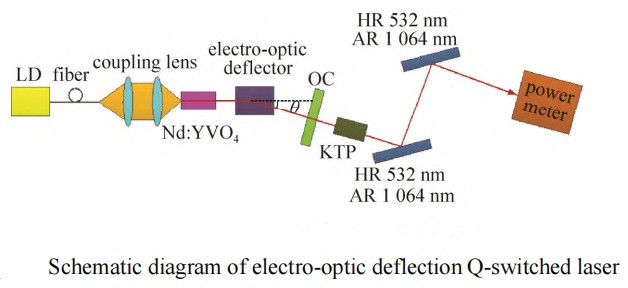1.2 E-O Deflector
The principle of Q-switching of E-O deflector is based on the E-O effect of some crystals. By applying potential difference between the electrodes of an E-O deflector, the linear electric field gradient makes the E-O deflector produce a linear refractive index gradient perpendicular to the laser transmission direction, which causes the laser beam transmission direction to be deflected. The E-O deflector has fast response speed up to nanosecond, and has advantages of simple structure, low insertion loss, low driving voltage, small size, easy control and high sensitivity. The schematic diagram of an E-O deflection Q-switched laser is shown in figure below.
In 1998, researchers used LD end-pumped Nd:YVO4 and E-O deflector Q-switching technology to obtain high-repetition frequency narrow-pulse laser output with repetition rate of 20 kHz, single pulse energy of 10.5 μJ and pulse width of 1.5 ns. This is the first report of E-O deflector applied to Q-switched laser.
In 2007, HORIUCHI R et al. used LD end-pumped Nd:GdVO4 and E-O deflector Q-switching technology to obtain laser output with repetition rate of 200 kHz, single pulse energy of 6.5 μJ and pulse width of 10 ns. The authors of this literature point out that the maximum repetition rate is limited by the duration of high voltage, and if the period is prolonged, then the repetition rate can be further increased. In 2008, HORIUCHI et al. obtained a laser output with repetition rate of 1.4 MHz, single pulse energy of 1.92 μJ and pulse width of 39 ns by using LD end-pumped Nd:YVO4 and E-O deflector Q-switching technology.
In 2016, Xu WANG et al. used LD end-pumped Nd:YVO4 and RTP E-O deflector as Q-switch to obtain laser output with maximum repetition rate of 20 kHz, single pulse energy of 133.5 μJ and pulse width of 2.2 ns.
Post time: Oct-03-2022

